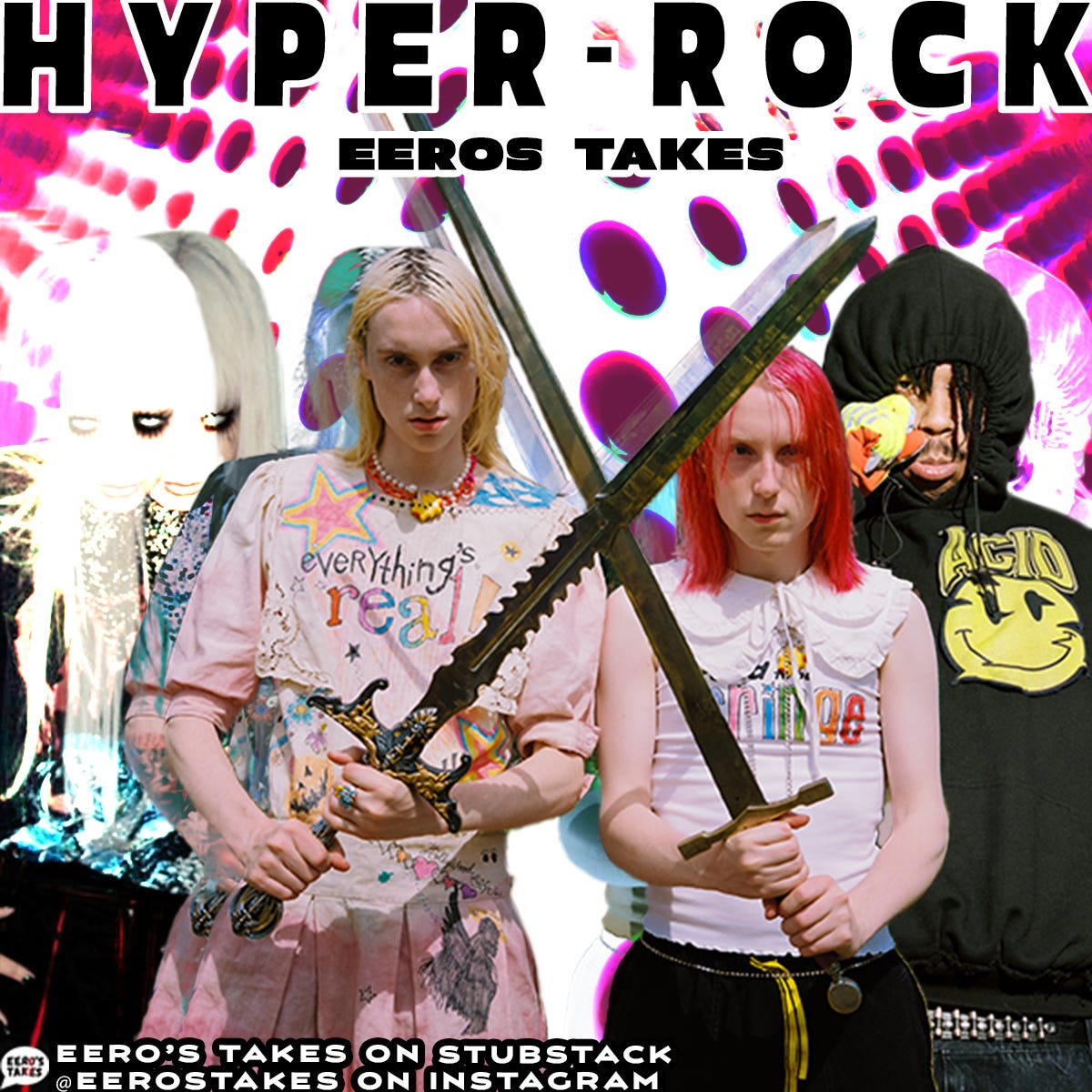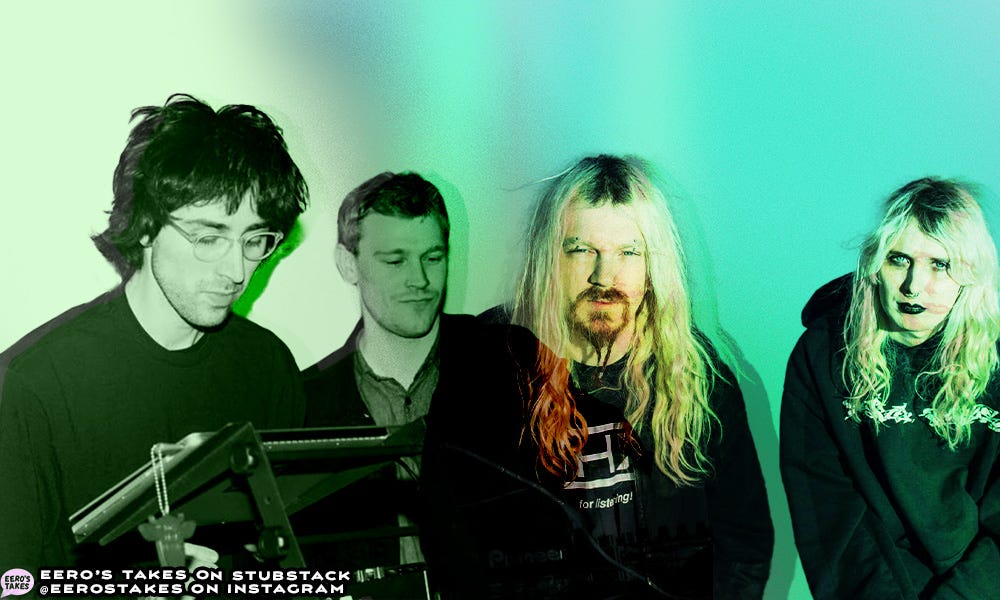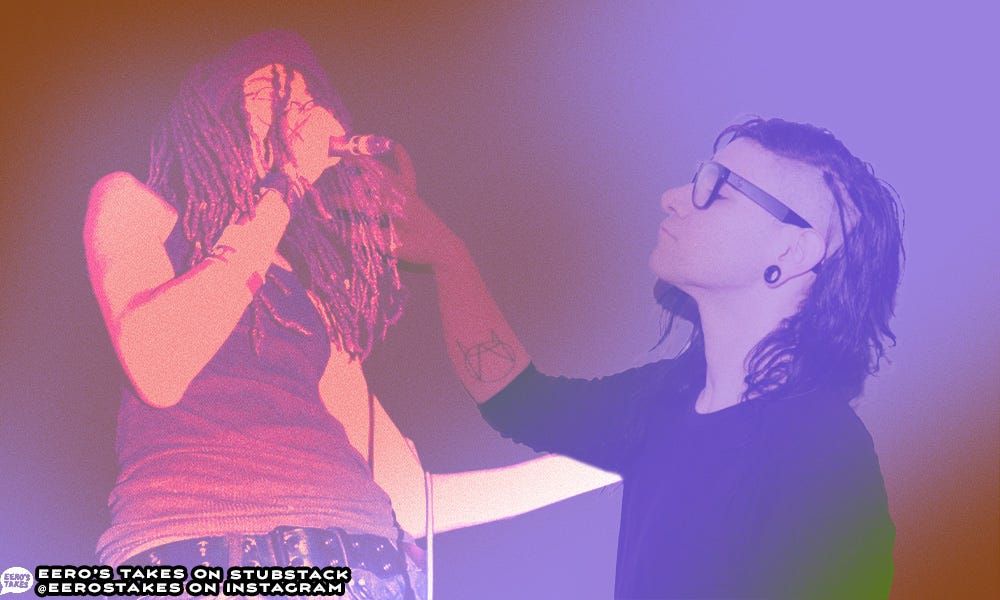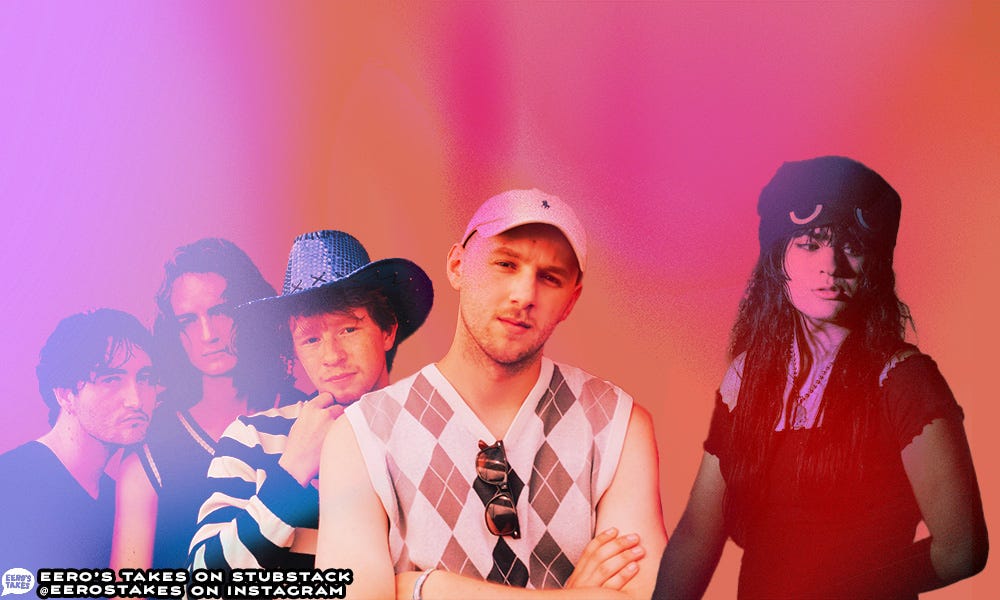Hyper-Rock? Really?
It has become divisive among niche internet music communities thanks to just one article, but what exactly is it?

Hyper-Pop is dead.
That's an accepted fact. Right? The era of overly eccentric Pop music is done, and there are many arguments as to why. Some argue it ended with the lift on the COVID-19 lockdown; others suggest it died alongside the late, now-iconic musician, SOPHIE. People are even willing to go against the grain and suggest that it wasn't a genre to begin with, just a term used to box in innovative electronic music (is this surprising, though? People love a good argument online.) There seems to be no definitive answer. The only thing the internet seems to agree on is that it is over... for now. But this death of Hyper-active Pop music makes the emerging idea of Hyper-active Rock music even more intriguing. Because what does that mean, really? Hyper-Pop was an over-exaggeration of classic pop tropes, so can that same idea be applied to rock music? Does it even work in practice?
I think so. And here’s why:
About a month and a half ago, I received two texts from a close friend. One contained a link, and the other read, "I think you'll be mad that you didn't write it yourself." The link he had sent me was to an article titled, ‘The Emergence Of Hyper-Rock,' by writer Daniel Feigelson. And he was right: I was annoyed that I hadn't been the one to write this article first, let alone thought of Hyper-Rock as a term. But in this annoyance came a greater sense of curiosity. What did Feigelson define as "Hyper-Rock?" How much did it align with the quickly developed definition that formed in my mind upon reading the title alone? I had to find out.
There's a purposeful shock factor in including indie-folk legend Alex G as one of the central portraits in the thumbnail of an article like this, especially when put next to the likes of Jane Remover and Yeule, two newer musicians of the internet era whose online presence lines up perfectly with one's assumptions as to what Hyper-Rock may be. In doing so though, Feigelson's argument quickly becomes clear: Hyper-Rock isn't a new genre. But before getting as to why that is, Feigelson opens his article by describing how his interest in defining the genre was first piqued when reading James Rettig's review of Feeble Little Horse's album Girl With Fish, where Rettig uses the term anxiously in passing with little definition. It's from this simple namedrop that Feigelson builds his piece, connecting this description of the FBH’s hazy guitar tones and digital textures to the developing Shoegaze Revival, the now defunct record label PC Music, Drain Gang, and other internet-adjacent movements. While he makes these connections, though, Feigelson explains how he believes the emergence of Hyper-Rock isn't from any particular place or scene, instead suggesting that it has been a slowly culminating movement that has become clearer with time. However, he does use three genres to create the backbone of his thesis: Shoegaze, Hyper-Pop, and Digicore.
Shoegaze, to Feigelson, is arguably the most vital parent genre to Hyper-Rock, mentioning names such as IDM-Rock fusion group Sweet Trip, Sigur Rós, M83, and others as examples of where Shoegaze and Electronica clashed at the turn of the millennia. He connects these initial innovations and their influence to the start of the Shoegaze Revival of the late 2010s and how cities like Philidelphia and Seoul continued to play essential roles in the fusion of Shoegaze and electronica, whether that be through They Are Gutting A Body Of Water's (TAGABOW) titular electronic textures or Parannoul's warped fusion of intense walls of guitar feedback and creative synth work. However, Shoegaze's habit of mixing rock and electronic music isn't the only reason he views it as crucial to Hyper-Rock: Its deep connections with indie and its innate nature as a genre bridge make it easy to crossover multiple scenes and sounds, hence the example Alex G., whose own use of vocal manipulation in his rock music aligned with the Shoegaze of surrounding fellow-Philly bands, and helped further define what Hyper-Rock sounded like. Shoegaze is influential to Feigelson because it is somewhat an over-exaggeration of rock music itself, much like how Hyper-Pop was to pop. Its flailing mounds of distortion & reverb, unconventional song structures, and mystifying lyricism create an almost faux-rock sound. Mix that in with the spastic nature of late 90s electronic music's own unconventional genres like IDM, and you can begin to see the outline of something transcending typical genre bounds.
We can't talk about Hyper-anything unless we talk about Hyper-Pop, too, and Feigelson is fully aware of this. Hyper-Pop acted (acts? I'm somewhat convinced we're about to see a Hyper-Pop renaissance) as a sandbox for creativity. Once freed from the shiny, well-polished walls of PC Music's early sounds, it became an open ground for DIY culture and crazed experimentation: musicians began mixing in guitars in their blared-out bass sections, digitally processed vocals, and transient synthetic sounds, including PC Music acts too as their roster grew. It was a creative time for popular music, and while its influence can still be heard today, its fire fizzled out quicker than it should. It's from the ashes of Hyper-Pop, though, that Feigelson suggests a new movement became afoot, noting that more successful names in the scene had either begun using rock aesthetics earlier on than most or have made complete transitions into Hyper-Rock bands, much like that of 100 Gecs or A.G Cook and EASYFUN's newest project, Thy Slaughter. The Hyper-Rock coming from this side of the spectrum is more free-spirited than what Shoegaze has influenced but still upholds many of Feigelson's necessary requirements: Pitch-shifted vocals, guitars, glitchy & distorted textures, and synthetic passages.
Hyper-Pop also stood as the parent genre to Digicore, a world Feigelson focuses on because of how many artists from that scene swiftly began making guitar music, whether it be Underscores, Brakence, or Jane Remover. Feigelson uses Jane as a prime example of where Hyper-Pop/digicore crossed roads with Hyper-Rock, with her 2021 record Frailty acting as a near-perfect example of the many characteristics defined by Feigelson: it's glitchy, vocally warped, guitar-oriented, and distorted. Jane's label, Deadair Records, also plays an integral role in Feigelson's Hyper-Rock definition, with fellow signees like Quadeca and quannnic operating in similar bounds with records like 2024's Scrapyard and 2022's kenospia garnering praise for their internet-rock experimentations. However, Deadair Records and its Digicore graduates also stand as a time measurement in Feigelson's assessment of the genre, with more recent releases from Remover and quannnic moving past their glitchy backgrounds into more traditional Post-Rock and Shoegaze soundscapes (although, I would argue against this with Jane; while her latest record is more Post-Rock oriented than ever, its stuttering drum patterns, vocal manipulation, and electronic textures are still prevalent on her latest release.) Feigelson argues that while perhaps Hyper-Rock is finally developing an almost cult-like following, it may have "a shelf life not dissimilar from hyper-pop." Only time can tell.
Feigelson's definition of Hyper-Rock makes a lot of sense, and his hypothesis of it not being an inherently new idea is captivating, too. I immediately think of groups like Panchiko for their bit-crushed guitars and skeletal electronic drum work, Four-Tet's Post-Rock group, Fridge, and IDM legend Aphex Twin's 1997 track Come To Daddy - Pappy Mix for its intense vocal fry, post-junglist drum machine rhythms and the drilling buzz of the riff that dominates the track. But, what was also interesting to me was how my initial definition, the one quickly assembled upon reading the title, did not fully align with Feigelson's Shoegaze-oriented one. Feigelson's background in Shoegaze was not a world I was familiar with. Upon reading the term for the first time, my mind immediately connected it to the punk-adjacent rock music I had come to grow appreciative of over the years. This contrast interested me not because Feigelson's definition is wrong (if you listen to his examples of it, it makes perfect sense), but more so was how Hyper Rock may be a more encompassing term than initially thought. Hyper-Rock, to me, has also come from a renewed interest in Punk-adjacent movements.
Punk's anti-establishment and youth-oriented nature led to an unforeseen rambunctiousness in its music and culture from its inception in the West during the seventies. That energy would come to change and branch off in various directions in the decades to come as new musicians and outside influences would make their way onto the sound. One of these scenes to come out of the punk sphere of influence would be Emo- a movement birthed from the East Coast Hardcore scene of the 1980s, taking a more emotional spin on the rough-and-ready nature of traditional hardcore. Emo's influence is absurdly widespread because it is an umbrella term for multiple genres itself, and a lot of them have found themselves influencing Hyper-Rock. But before I get to those, I want to start with Skrillex, the original Digi-Emo.
Skrillex's career in music started as the frontman of a post-hardcore (Emo) band named From First To Last in the mid-2000s. While his time with From First To Last was short-lived, with him leaving the band in 2007, its influence on what was to come for his career would be massive. At the start of the 2010s, Skrillex would dominate the once-minimalist-oriented world of Dubstep with his punk-riff-inspired synthesizers and emotional guest vocalists, who often emanated the performative-sorrow upheld by another 2000s Emo movement: Pop-Punk. Now, am I saying that Skrillex is the original Emo-Hyper-Rocker? No. But I am saying he did have his influence. It was the first time many future Gen Z musicians would be exposed to a combination of rock and electronica in a way that hadn't been seen before. By the late 2010s, groups like 100 Gecs would apply similar formulas to their Hyper-Rock and simultaneously set a precedent for emo-inspired electronica. Frost Children would be another example: Their debut, Aviation Creates Adventurous Beginnings, would generally fly under the radar of most, but was also the Frost Children's first time mixing minimalist electronica with large, manipulated Pop-Punk choruses, meaty riffs, and chaotic drumming, digital and analog alike. Later projects, like 2022's Spiral, would follow more linear song structures but continue to mix and mash Pop-Punk with more Bro-Step-oriented dance music, creating cyber hits like FOX BOP and SNAILS PACE. And how can we forget their song BL!NK, whose chorus glitchily sings, "I think I was made from a shooting star! Because I'm gone in a Blink, like 182!-2-2-2-2-2!"
However, Quinn's track, can you really blame me for how i react was my first encounter with this sound. And while perhaps she's moved into more trap-oriented territories with her music these days, this track is a quintessential example. It's a pure representation of the emotionality of Emo lyricism and the rawness of its punk roots through unfiltered snare thwacks contrasting grating saw waves and wailing cries of anger whose sorrow is emphasized through eclectic layers of autotune. Quinn isn't the only example of Hyper-Rockers making raw, emotionally intensive, Emo-inspired rock music, though, as Underscores (April Harper Grey) became a pillar of this sound with 2021's Fishmonger. At release, Fishmonger was distinct in its approach to what was widely considered just Hyper-Pop because it was a clash of Hyper-Pop, Pop-Punk, and Trap Music. Tracks like Bozo bozo bozo and Your favorite sidekick are defined by their trap percussion, blaring 808 bass kicks (not dissimilar to Skrillex, a name Grey has mentioned as one of her biggest influences), Pop-Punk oriented riffs, pitch-shifted hooks, and tight, bright arpeggios, which are contrasted by the more somber yet adamantly still hyper-cuts like The fish song and Del mar county fair 2008. Grey had introduced a new element to Hyper-Rock that made her sound stick out. Her unapologetic use of Modern Trap elements wasn't new to Hyper-Pop, but it hadn't been merged with Rock Music so intensively. Many Trap-oriented Hyper-Pop songs were focused on a hardcore aspect, centered around their energy rather than structure and catchiness. Fishmonger would take this fierceness, structuring it around Pop-Punk's chorus-oriented song structures, creating a Hyper-Rock record that reflected Grey's influences and the scene at the time.
Liverpool Rock outfit Courting would also take to Trap Music but would apply it to the revitalized Art-Rock scene that was beginning to flourish across the UK on their 2022 record, Guitar Music. Art Rock is another one of those terms used in music to encompass a variety of subgenres: Post-Punk, Garage Rock, Psychedelic Rock... they all play their role in creating the very openly defined Art Rock category. And Courting, knowing this, plays into the openness of the term: their sound is a culmination of it all. They play upon The Strokes' sarcasm, the intensity of their contemporaries (think a la Black Country, New Road, or Black Midi), and above it all, mix in non-Rock influences more apparently than others, making their take on Art Rock wholly Courting's. These outsider influences show through Pop Music's catchiness, the magnitude of Industrial Music, the jittery nature of Trap Music, and the intensive use of autotune. Guitar Music was Courting's first exposé of their genre-mashing, and the result was evidently hyper-active. It shimmers under the waves of synthesizers and crashes with the stomp and smack of its industrial drumming that are definitive aspects of tracks like Cosplay / Twin Cities and Famous. Other tracks like Loaded lean into Courting's liberal use of autotune and glitch--aesthetics, all before leading up to the elaborate Uncanny Valley Forever- an eight-and-a-half-minute epic that gorgeously exaggerates their Pop influences through its obsessive lyricism and passionate performances of lines like "She's my American Princess!" But more importantly, it brings Art Rock and Hyper-Rock together: Its lengthy composure merges with the glitchy textures, saturated autotune, and digital drum work to create an avant-garde work representative of the internet era in its completion.
If we travel back to the States, to the West Coast, we can find another world merging Hip-Hop, Punk, and Hyper-Pop: Los Angeles' thriving indie scene. LA's indie scene culminates so many different points in modern music culture: R&B, Hip-Hop, Rock, Pop... you name it. This mixing pot of sounds often leads to more tame, chill-out music, especially following the success of musicians such as Tyler, The Creator, Kali Uchis, and others from the early LA indie era. But in between the cracks, chaos ensues. The rising popularity of LA indie perfectly aligned with the growth of the Hyper-Pop movement that was also sprouting out of the city at the time, leading to these two worlds colliding on occasion, like when Glitch Gum remixed Phoebe Bridgers' hit Kyoto or when Clairo voice was deeply coated in autotune to create a dance-pop banger on Mura Masa's 2019 record, RYC. These small instances helped lead to bigger crossovers between sounds, like the work of Jean Dawson: genre's worst nightmare. Jean has always advertised himself as a man whose music can't be defined: he pulls from all-over music to create his art. From this, though, he creates moments that can align with Hyper-Rock. 2020's Pixel Bath is characterized by its rock-intensive sound and glitchy vocal embellishments. Tracks like Dummy emphasize Jean's creativity through its stuttering chops, bright major-key chords, and his playful use of his voice and meter, jumping from shouting to falsetto, singing in triplets on the verse, and elongating his vowels to stretch and play with he can sound like. The track's junglist drumming is also captivating and ever-so reminiscent of Orange County Jungle Punks: The Garden, another LA collective that plays around with rock music's exaggerations.
While they have a more rooted basis in the West Coast Punk scene, Jean Dawson's sentiment is similarly echoed, even behind their ghastly face paint and drawn-back personalities. However, their mix of Jungle and Drum and Bass is ever so intriguing- can this be considered, at least to some extent, Hyper-Rock? A track like the sardonically titled Kiss My Superbowl Ring is a tightly knit mix of amen breaks, buzzing 808 bass hits, shredding surf rock riffs, jangly melodies, and extensive amounts of crassly-coated shouting. Perhaps The Garden themselves are more Hyper-Rock-adjacent than directly involved; their collage of UK bass music and Californian Punk will undoubtedly cross paths with autotune and glitch music at some point down the line: it just might not be done by the Garden.
Hyper-Rock is a captivating idea. It's a crossroads between so many revitalized points within music that would only have been able to reach the status it has through the internet. Feigelson's definition of Hyper-Rock has laid the groundwork, leaving room for additions. And while I fully back the idea of Hyper-Rock, much like Feigelson, I question its shelf life: Underscores' latest release, Wallsocket, much like Jane's, opted for a more Rock-oriented approach with some small glitchy highlights. The Frost Children's latest release, Hearth Room, dropped the duo's electronic background entirely in favor of a twee-emo Pop sound. Jean Dawson's latest releases have aimed for more polished, Rock-oriented balladry. The online response to the term wasn't as positive as initially expected, either; in the eyes of online music discussion, many view Hyper-Rock as a vapid umbrella term. However, there has also been an increase in positive reactions to Feigelson's definition, with smaller musicians online taking to the idea and even catching the eyes of larger entities; Spotify now offers a Hyper-Rock mix similar to Feigelson's article. Hyper-Rock needs time to grow and perhaps requires a definitive direction to follow to stay afloat, but that can only be done if given the chance to do so. And I think it will: in the growing world of Guitar Music, Hyper-Rock has a spot in it. The future of Hyper-Rock is up in the air, waiting to be pulled back to the ground.







“Skrillex's career in music started as the frontman of a post-hardcore (Emo) band” - did not know this, makes *so* much sense!